Coins of the Australian dollar
Coins of the Australian dollar were introduced on 14 February 1966, although they did not at that time include one-dollar or two-dollar coins. The dollar was equivalent in value to 10 shillings in the former currency (half of a pound).
Regular coinage
Produced by the Royal Australian Mint, all current coins portrayed four versions of the effigy of Her Majesty Elizabeth II, Queen of Australia, on the obverse, the first effigy designed by Arnold Machin, the second effigy designed by Raphael Maklouf, the third effigy designed by Ian Rank-Broadley and the fourth effigy designed by artist Jody Clark. This is matched with designs by the Australian-born artist Stuart Devlin on the reverse. They now comprise 50c, 20c, 10c and 5c coins—all still referred to as 'silver' though actually 75% copper and 25% nickel, and for many years there were also "bronze" 2c and 1c coins.
The 50c coin originally had a circular shape, and contained 80% silver and 20% copper, so that the material of the coin was worth more than 50c. It was made to almost identical dimensional specifications as the British 2/6 coin, the half crown. However, to avoid confusion among the round coins, and because of its excess value, it was only produced for one year then withdrawn from circulation; there were no 50-cent coins minted for 1967 or 1968. It was changed to a 12-sided shape for 1969 and all following years, but the 12-sided issue was minted as a specimen piece in 1966–67 to test the design. It has since been issued in both standard and commemorative designs.[1]
The standard designs on both versions of the coin are the same: the obverse carries the effigy of the sovereign, and the reverse shows the Coat of Arms of Australia. The dodecagonal version has a mass of 15.55 g and a diameter of 31.5 mm, and the round silver version has a mass of 13.28 g and diameter of 31.5 mm. 94.13 Australian 1966 round 50c coins make up a fine kilogram of silver.
"Gold" one-dollar and two-dollar coins were introduced in the 1980s. The one-dollar coin was introduced in 1984, to replace the banknote of the same value. The two-dollar coin, also replacing a banknote, was introduced in 1988. These have content of 2% nickel, 6% aluminium and 92% copper. Thus, all Australian coins in use currently are composed of more than half copper. The two-dollar coin is smaller in diameter than the one-dollar coin, but the two-dollar is slightly thicker.
The one- and two-cent coins were discontinued in 1991 due to the metal exceeding face value and were withdrawn from circulation. As of 1991, both the 1 and 2 cents are now minted as collectors coins. Australian coins have medallic orientation, as do most other Commonwealth coinage, Japanese yen coinage, and euro coinage. This is in contrast to coin orientation, which is used in United States coinage.
Table
| Australian coins [2] | ||||||||||
|---|---|---|---|---|---|---|---|---|---|---|
| Image | Value | Technical parameters | Description | Date of first minting | ||||||
| Obverse | Reverse | Diameter | Thickness | Weight | Composition | Edge | Obverse | Reverse | ||
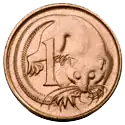 |
1c (no longer used as of 1991) |
17.65 mm | >1.4 mm | 2.60 g | 97% copper 2.5% zinc 0.5% tin |
Plain | Queen Elizabeth II | Feathertail glider | 1966 | |
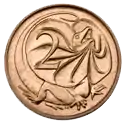 |
2c (no longer used as of 1991) |
21.59 mm | <1.9 mm | 5.20 g | Frill-necked lizard | |||||
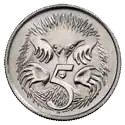 |
5c | 19.41 mm | 1.3 mm | 2.83 g | Cupronickel 75% copper 25% nickel |
Reeded | Queen Elizabeth II |
Echidna | 1966 | |
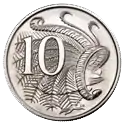 |
10c | 23.60 mm | 2.0 mm | 5.65 g | Superb lyrebird | |||||
 |
20c | 28.65 mm | 2.5 mm | 11.3 g | Platypus | |||||
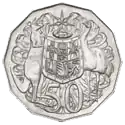 |
50c | Dodecagon 31.65 mm (across flats) | 2.5 mm | 15.55 g | Plain | Coat of arms | 1969 | |||
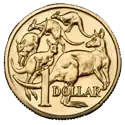 |
$1 | 25.00 mm | 2.8 mm | 9.00 g | 92% copper 6% aluminium 2% nickel |
Interrupted milled |
Queen Elizabeth II |
Five kangaroos | 1984 | |
 |
$2 | 20.50 mm | 3.0 mm | 6.60 g | Aboriginal elder and Southern Cross | 1988 | ||||
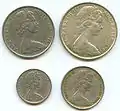 Effigy of Elizabeth II by Arnold Machin displayed on coins minted in 1966.
Effigy of Elizabeth II by Arnold Machin displayed on coins minted in 1966.
Commemorative coins
Commemorative coins have been produced for various denominations in various years with imagery representing an event replacing the usual design on the reverse side of the coin. In some years, all the coins of that denomination are replaced with a different design for that year. In other cases, only a few million coins have the commemorative design, and coins with the standard reverse are also released.
No commemorative issues of the 1c and 2c coins have been produced, and with the exception of the 2016 issue, there have been no commemorative issues of the 5c and 10c coins. Many commemorative versions of the 50c coin have been placed in general circulation since 1970. The first $1 coin commemorative issue was in 1986, the first 20c commemorative issue in 1995, and the first $2 commemorative issue in 2012. Mintages reported for these coins vary from around 500,000 to around 50 million.
In 1992 the Mint commenced production of commemorative issues which were not for circulation. Mintages reported for these coins vary from around 5,000 to around 125,000, with the notable exception of the four 25c coins of 2016 which have mintages of 1 million each.
In 2016, to celebrate 50 years of decimal currency, a commemorative design for the obverse of the coins was released. To date this is the only issue where the commemorative design is on the obverse face rather than on the reverse face.
Collectable coins
The Royal Australian Mint regularly releases collectable coins, one of the most famous of which is the 1980-1994 gold two-hundred-dollar coin series. Australian collectable coins are all legal tender[3] and can be used directly as currency or converted to "normal" coinage at a bank. Metals include aluminium bronze, silver, gold and bi-metal coins.[4] Nugget coins are issued in ounces and fractions or kilograms and come in gold and platinum, some are denominated in dollars, and others by their weight value.[5]
See also
Notes
- A guide to Australian decimal coins, 20 April 2017
- coin designs and what we make, Royal Australian Mint, archived from the original on 11 February 2014
- frequently asked questions, Royal Australian Mint, archived from the original on 11 February 2014
- Pitt 2000, pp. 90–100.
- Pitt 2000, pp. 101–109.
References and further reading
- Australian coins price guide and values - Pre-decimal coins
- Krause, Chester L.; Clifford Mishler (2003). 2004 Standard Catalog of World Coins: 1901–Present. Colin R. Bruce II (senior editor) (31st ed.). Krause Publications. ISBN 0873495934.
- Pitt, Ian W. (2000), Renniks Australian Coin and Banknote Values (19th ed.), Chippendale, N.S.W.: Renniks Publications, ISBN 978-0-9585574-4-3
- Cruzi's Coins
- Australian Commonwealth Coinage, 21 April 2009, archived from the original on 8 December 2013
- Australia's first coins, State Library of NSW, archived from the original on 2 February 2014, retrieved 6 September 2011
- Australian Decimal Currency, archived from the original on 27 December 2012
- about reverse designs, Royal Australian Mint, archived from the original on 11 February 2014
- Internet FAQ, Royal Australian Mint, archived from the original on 5 September 2008